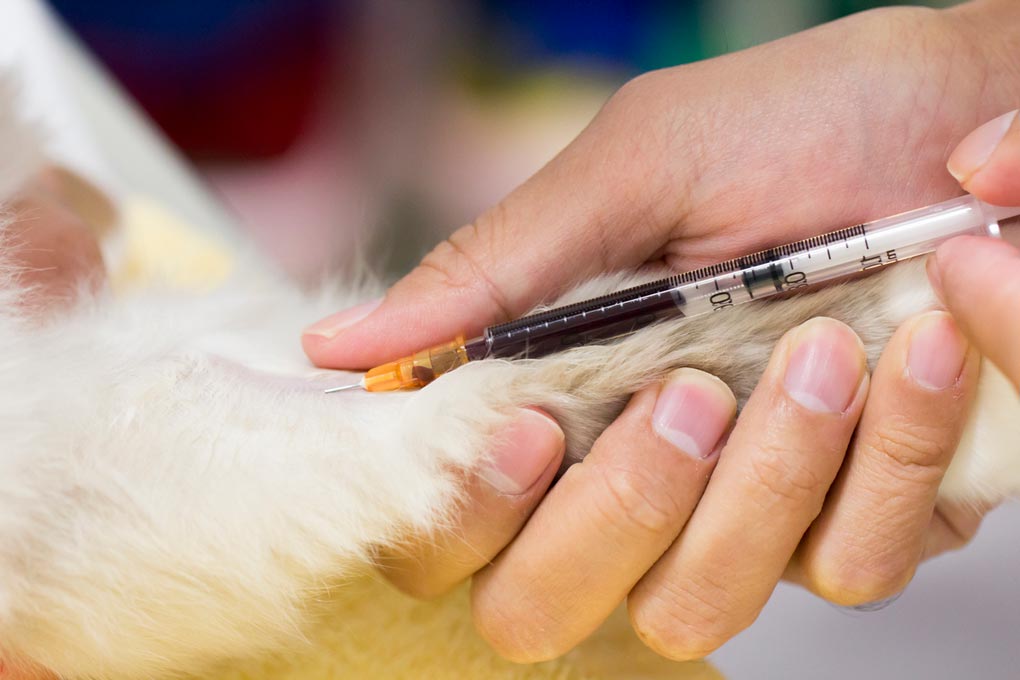Common Blood Tests Done on Cats

When your veterinarian recommends blood work on your cat, do you know what information about your cat's health the doctor is trying to gain? Below are some of the common blood tests done on cats and what they tell the veterinarian.
CBC
A CBC, or complete blood count, measures and examines a cat's blood cells. It gives the veterinarian a wealth of information. Some of this includes:
- Red blood cell (RBC) counts, proportions, and health. RBCs carry oxygen, iron, and other nutrients around the body.
- White blood cell (WBC) counts, proportions, and health. WBCs help fight inflammation, infection, cancer cells, and parasitic intruders.
- Platelet counts and health. Platelets control blood clotting.
A CBC can tell a veterinarian if a cat is anemic, dehydrated, fighting some sort of inflammation or infection, and whether there is internal bleeding occurring.
BUN and Creatinine
Blood urea nitrogen (BUN) and creatinine are blood chemistries that are routinely measured as part of larger blood panels. If the BUN is high, it can indicate dehydration, kidney dysfunction, or a liver problem.
Creatinine levels are more strictly related to kidney function. High levels indicate that the cat's kidneys are having difficulty clearing the creatinine from the body and kidney disease may be present.
ALT and Bilirubin
Alanine Aminotransferase (ALT) and bilirubin are blood chemistries that are also often present in routine blood panels. They are mostly indicative of liver health, and if they are too high, it usually indicates a liver dysfunction of some kind.
Glucose
Glucose, or blood sugar, is mostly tested to determine whether a cat has diabetes mellitus, during which the glucose result will be quite high. Low blood sugar can also give a veterinarian valuable information about a cat's health.
FELV and FIV
Feline leukemia virus (FELV) and feline immunodeficiency virus (FIV) are routinely tested for in kittens and periodically throughout adulthood. These viruses are serious, life-threatening, and can't be cured once a cat is infected, so it's important to keep tabs on a cat's status with regards to them.
T4
Thyroxine (T4) is usually monitored in cats as they get older. A high T4 might indicate the development of hyperthyroidism, a commonly diagnosed condition in cats. High thyroid levels can cause a myriad of different signs in cats, including increased appetite, weight loss, eating non-food items or wanting more human food, and increased vomiting.
Electrolytes
Electrolytes levels, including potassium, sodium, and chloride, can tell a veterinarian a lot about a cat's health status, including information about hydration levels and organ function, especially the kidneys. Electrolyte imbalances can result in many signs of illness in cats, including heart arrhythmias and muscle weakness.
When Do Veterinarians Recommend Blood Tests in Cats?
Veterinarians often recommend blood screens on cats yearly or twice yearly to monitor for indications of illness or disease. Sometimes the doctor can catch something like kidney disease in its earliest stages by doing this. For example, a cat might have higher BUN and creatinine levels than they did the year before, even though they are not yet above the normal ranges for those values. If blood work had not been done routinely, this comparison would be impossible. Instead, steps may be taken to help support the kidneys earlier than they otherwise would be.
Whenever a cat is showing signs of illness, blood work is one of the first recommendations. Not only can it aid in giving information that can help with diagnosis, but it can also show the veterinarian what treatments might help the cat. For example, if the kitty is slightly dehydrated, regardless of the cause, fluid therapy might improve the signs.
How Is Blood Work Done on Cats?
Drawing blood from a cat can sometimes be challenging, but your veterinary staff has tremendous experience both with the best methods of calming and restraining your cat and with actually drawing the blood. Blood may be drawn from the top of the front leg (the cephalic vein), the inside of the back leg (the saphenous vein) or the front of the neck (the jugular vein). Some people are upset when they see blood being drawn from the neck, but it is a safe and effective way of collecting big blood samples quickly in cats.
Once the blood is drawn, the veterinarian or veterinary staff member will place some in each of two or more different blood tubes. The tubes contain various chemicals that help prepare the blood for the tests that will be run. Some of the blood is spun in a centrifuge to separate components for testing.
There are a variety of machines that can test feline blood, and many veterinary clinics have the ability to run at least basic tests. Blood can also be placed on a slide and examined under a microscope to gain more information for the CBC portion.
Can Blood Work Provide a Diagnosis?
There are times when blood tests alone can diagnose a condition. However, more often, blood work results are used in conjunction with the results of a thorough history of the patient's signs, a complete physical examination done by the veterinarian, and other tests. Sometimes these things suggest a particular diagnosis, which then requires further testing to confirm. Some other tests that might be necessary could include:
- X-rays can provide a look inside the body at organ size and shape, some tumors, bone abnormalities, bladder and kidney stones, and intestinal obstructions among other things.
- Ultrasound uses sound waves to provide pictures of internal structures for the veterinarian to evaluate. It can also be used to direct a veterinarian who is doing a needle aspiration of an organ or structure.
- CT scan uses multiple x-rays and a computer to produce cross-sectional images of internal body structures.
- MRI uses magnets and radio waves to produce cross-sectional images of internal body structures.
- Fine needle aspiration is a technique that involves placing a fine gauge needle into an organ, lymph node, or tumor and withdrawing cells to examine under a microscope.
- Further blood tests might need to be done which target more specific illnesses and conditions. For instance, when a doctor suspects a thyroid condition based on signs, history, and a high T4 level, he or she may recommend a more complete thyroid panel that can more specifically diagnose hyperthyroidism.
You May Also Like These Articles:
Fine Needle Aspiration: FNA in Cats
MRI in Cats: What Is It and Why Might Your Cat Need It?
FIV: Feline Immunodeficiency Virus
Notice: Ask-a-Vet is an affiliated service for those who wish to speak with a veterinary professional about their pet's specific condition. Initially, a bot will ask questions to determine the general nature of your concern. Then, you will be transferred to a human. There is a charge for the service if you choose to connect to a veterinarian. Ask-a-Vet is not manned by the staff or owners of CatHealth.com, and the advice given should not delay or replace a visit to your veterinarian.






